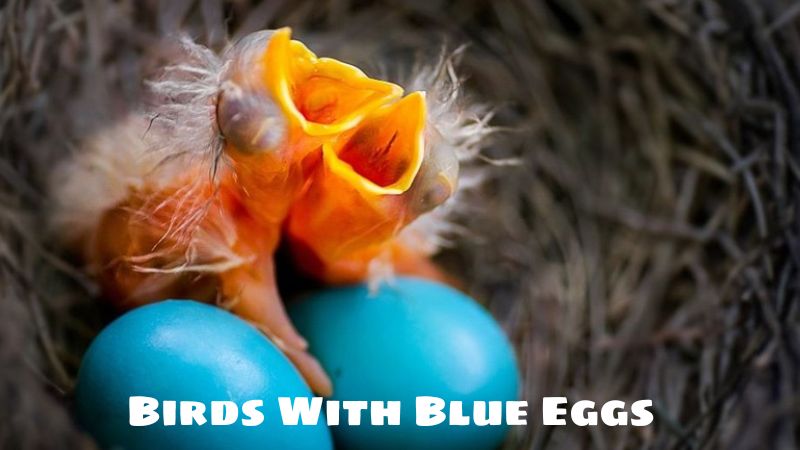Birds with blue eggs are one of the miraculous phenomena and attract the attention of biologists and nature lovers around the world. The green color of bird eggs is the result of the accumulation of biliverdin, a substance synthesized from green molecules in the bird’s body.
This creates a distinctive shade, ranging from pale blue to bright green, depending on the bird and its habitat. This color is not only an expression of diversity but also part of the adaptation and evolution of birds on this planet. Let’s explore more closely with Exoticbirdscorner about the case of birds with blue eggs!
Birds have blue eggs
In the wonderful natural world, we are not only overwhelmed by the countless species of birds with their brilliant plumage but also by the variety of colors of the eggs they lay. Standing out among the natural color palette, blue eggs always attract attention because of their unique beauty and hidden many interesting things.
Across the continents, blue eggs can be found in the nests of many different bird species. Some typical representatives can be mentioned as:
- Macaw Parrots: Famous for their colorful feathers, Macaw Parrots also possess brilliant blue eggs, dotted with delicate brown spots.
- Bumblebee: This familiar bird in Vietnamese folk songs also possesses light blue eggs, with quite thick and shiny eggshells.
- Swallow: This small, agile bird has dark blue eggs dotted with tiny brown dots.
- Ringworm: This bird with a clear chirping sound also has lovely jade green eggs, with thin and quite smooth eggshells.
- Cockatoo: This small parrot has light blue eggs, with quite thick egg shells and delicate veins.
What is interesting is that the blue color of bird eggs is not simply an aesthetic beauty but also contains many important meanings. Blue is thought to protect eggs from the harmful effects of UV rays from the sun, help regulate the temperature inside the eggs, and may even influence the behavior of young birds after hatching.
The variety of green shades on the eggs of different birds, from green, blue, turquoise, blue,… creates an extremely vivid and colorful picture of nature. Each shade of green has a unique beauty, contributing to making the natural world richer and more magical.
Explain why birds with blue eggs
The blue color on bird eggs has long been a subject of scientific curiosity because of its unique beauty and hidden meanings. Unlike the white color common in other birds, the blue color on bird eggs brings many interesting and surprising things.
The mystery behind this blue color is the presence of the pigment biliverdin, a product converted from hemoglobin in the mother bird’s blood. When the mother bird lays eggs, biliverdin is moved from the blood into the eggshell, creating the characteristic blue color.
The blue color of bird eggs is not only an aesthetic beauty but also plays an important role in the protection and development of young birds. The green color helps the eggs blend in with the surrounding environment, especially the foliage, creating an effective camouflage layer, helping to shield the eggs from the sight of predators such as snakes, feral cats,…
In addition, blue also has the ability to absorb light better than other colors. Thanks to this feature, bird eggs can effectively absorb temperature from the surrounding environment, helping the mother bird regulate the temperature in the nest, ensuring stable development for the embryo inside.
What’s even more interesting is that some scientific studies show that blue can stimulate the vision and activity of young birds after hatching. Blue is said to attract the attention of young birds, helping them easily recognize mother birds and find food.
Thus, the blue color on bird eggs is not only a unique beauty but also has many important meanings in the protection and development of young birds. This green color is a testament to the magic of nature and the perfect adaptation of birds in their environment.
The meaning behind the blue color of bird eggs
The blue color on bird eggs is not only a unique beauty but also has many important meanings, contributing to the survival and development of the species.
1. Protect young birds
The green color of bird eggs acts as an effective camouflage layer, helping to blend in with the surrounding environment, especially tree foliage. Thanks to that, bird eggs become difficult to detect by predators such as snakes, wild cats, falcons, etc. The survival rate for young birds after hatching is also significantly increased.
2. Temperature adjustment
Blue has the ability to absorb light better than other colors. This characteristic helps the mother bird effectively regulate the temperature in the nest, ensuring a suitable living environment for the development of the embryo. This is especially important in harsh environments where temperatures can change suddenly, affecting the development of young birds.
3. Attracting mates
Some scientific studies show that the blue color on eggs can play a role in attracting mates and increasing fertility in some bird species. Male birds are often attracted to dark blue, shiny eggs, demonstrating the female’s good fertility. Therefore, female birds with beautiful blue eggs will have more chances of being chosen by male birds for pairing and breeding.
Thus, hidden behind the unique beauty of the blue color on bird eggs are important meanings that help protect young birds, regulate temperature and attract mates. Blue is a testament to the magic of nature and the perfect adaptation of birds in their environment.
Interesting exceptions in bird egg color
Besides the popular blue color, the world of bird eggs also contains many interesting things with a variety of colors. Not all birds lay blue eggs, and there are unique exceptions that create a colorful picture of nature.
The diverse beauty of bird eggs
In fact, bird egg colors are not limited to blue. We can see eggs that are pure white like the Pigeon, dark brown with black spots like the Quail, or light blue dotted with tiny brown spots like the Swallow. This diversity is the result of differences in pigmentation and breeding habits of each bird species.
- Biliverdin pigment: The common blue color on bird eggs is due to the presence of biliverdin pigment, a metabolic product of hemoglobin in the mother bird’s blood. However, in some bird species, biliverdin is produced less or is covered by other pigments, leading to distinct egg colors.
- Brown: The brown color on bird eggs is often due to the accumulation of melanin, a pigment that plays a role in protecting eggs from the harmful effects of UV rays. Brown is common in birds that nest on the ground or in places with little shade.
- White: White eggs are common in birds that nest in caves or hidden places, with little risk of being attacked by enemies. White color helps eggs easily blend in with the surrounding environment, creating effective camouflage.
Egg color may change:
Bird egg color can vary slightly depending on the mother bird’s diet and living environment. For example, birds that eat a lot of fruit may lay brighter colored eggs, while birds that eat insects may lay darker colored eggs. In addition, the living environment also affects egg color, for example, birds living in high mountains may lay eggs with lighter colors than birds living in the plains.
The variety of bird egg colors is not only a unique beauty but also reflects the perfect adaptation of birds to their living environment. Each color has its own meaning, contributing to the survival and development of the race.
Epilogue
Birds with blue eggs are a fascinating phenomenon in the animal kingdom, with the color often associated with the diversity and abundance of bird species around the world. The green color of eggs is created thanks to the green substance biliverdin, secreted by birds during egg formation.
This is not only an example of natural creativity but also an evolutionary adaptation to protect the egg and strengthen the bond between mother and child. Researching and protecting these birds not only helps maintain biodiversity but also opens up new opportunities in scientific research and environmental conservation.





